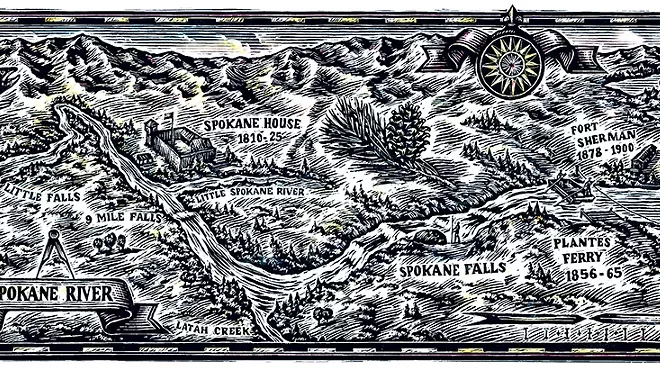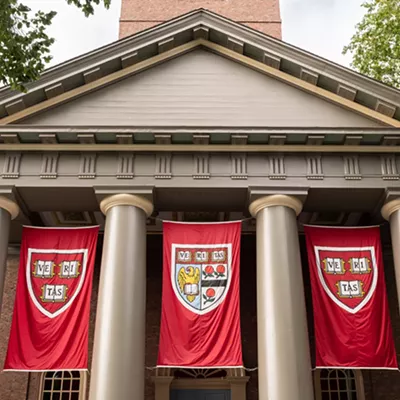I live in the watershed of the Spokane River. These are my home waters. I care for the river. Two hundred years ago, at the time of Lewis and Clark and British explorer David Thompson, the Spokane River was a wilderness river rich with salmon. Pure water flowed from the Bitterroot Mountains to the Columbia River.
Now the salmon are gone, the wilderness is mostly gone and the Spokane River is sick. But there is still much to save and restore. The river needs our help.
Our community invited the world to the Spokane River. Thirty years ago, during Expo '74, a world's fair was held at the waterfall and islands of the Spokane River. Expo '74 was the first international exposition to celebrate the environment. It was a watershed event, reconnecting the community to the river, and marking the flowering of an environmental ethic in the Spokane region.
To heal the river we must recognize two basic problems: water quality and water quantity. I want to focus on two major threats to the Spokane River: "Toxic Floods" and over-pumping of the aquifer.
Toxic Floods
Warning signs posted along Spokane River beaches alert the public to risks of lead and arsenic. Health advisories warn us about eating fish contaminated by lead.
Upstream, the Coeur d'Alene mining district — the fabled "Silver Valley" — once was among the world's richest silver- and lead-mining districts, with $4 billion of minerals taken from the valley. Mining wealth once washed into Spokane; now, it is the mine wastes that wash into Spokane.
Silver Valley mines created toxic wastes: 60 million tons containing lead, arsenic, cadmium and zinc were dumped directly into the Coeur d'Alene River and its tributaries.
Flowing water carried these toxicants downstream, especially during floods. Mine wastes mixed with clean soils. The 15,000 wetland acres between Lake Coeur d'Alene and the Cataldo Mission are covered by 100 million tons of toxic material. Lake Coeur d'Alene's bottom is covered with 60 million tons of toxic material. The Spokane River is also impacted — all the way to its confluence with the Columbia River.
Floods are getting worse and more frequent. The U.S. Forest Service was created to guard our forested watersheds. But instead, the Forest Service bulldozed thousands of miles of logging roads and clearcut the forests in the watershed — worse treatment than any other national forest in the United States received.
Add together the world's worst case of mine-waste pollution and America's most heavily damaged national forest, and you have the Spokane River's toxic floods.
In just a single day in February 1996, floods carried more than 1 million pounds of lead into Lake Coeur d'Alene, much of it exiting into the Spokane River.
In treating this chronic disease, there is good news and bad news. First the good news: last August, the EPA finally released its Superfund cleanup plan for the Coeur d'Alene Basin. And the bad news? Four glaring problems:
(1) the federal government's cleanup plan completely ignores the damaged forests and their contribution to the movement of pollution in the basin;
(2) the plan also ignores the 60 million tons of toxic waste at the bottom of Lake Coeur d'Alene that could be resuspended in the lake water and the Spokane River;
(3) the institution charged with implementing the cleanup plan, the Coeur d'Alene Commission, is not committed to the cleanup; and
(4) the Republican Congress and President Bush are steadfastly opposed to funding Superfund. No money, no cleanup.
Water Mining
Let's refocus from water quality to how much water is actually flowing in the Spokane River. The aquifer is the lifeblood of the Spokane River in the summer and fall months. They are inseparable: pump the aquifer, rob the river.
We are drying up the Spokane River (and Little Spokane River) by sucking the aquifer: a death by a thousand sucks.
Who is after aquifer water? Avista Utilities for one. Avista has applied for a water right for a power plant near Rathdrum. Avista (formerly Washington Water Power) has already done more to damage the Spokane River with its dams than perhaps any other single institution. To help the Spokane River, our community needs to ask Avista to withdraw its water rights application.
An even bigger "water buffalo" is the City of Spokane, and here the threat is enormous.
Between 1907 and 1961, the Department of Ecology granted Spokane the rights to pump water at the rate of 240,000 gallons per minute — up to 48 billion gallons of water per year. This is enough water to cover the land area between Spokane and Coeur d'Alene with a one-foot-deep layer of water.
Spokane's water rights equal 538 cubic feet per second, which on hot summer days, is a large percentage of Spokane River flow. The City pumps from two huge wells, 48 feet in diameter, directly adjacent to the river near Upriver Dam. Those wells capture water that would otherwise be flowing in the river within days or hours.
Spokane only uses about half of the water that it holds rights to on paper. Spokane also has the highest water usage in the state — city residents consume more than 1,000 gallons per day per household in the summer time, a truly astonishing and shameful amount of water.
When Ecology issued all these water rights to the City, it didn't give a single thought to what would happen to the Little Spokane and Spokane rivers if Spokane actually pumped all of its "paper" water rights. Ecology didn't ask Spokane to justify why it needed so much water. And Ecology didn't ask the City to create a water conservation program to reduce the impacts on the rivers.
The City does virtually nothing to encourage conservation — and has even sent mailings to city residents encouraging them to "use what you need." The City's involvement in a watershed planning process has focused on retaining veto authority to prevent adoption of meaningful conservation standards.
As it turns out, Spokane is not the only city that holds huge, unneeded paper water rights. The Department of Ecology issued thousands of paper rights to municipalities around the state. But in 1997, the Washington Supreme Court ruled that this practice was illegal, properly throwing into question the validity of Spokane's unexercised water rights.
The City of Spokane has joined with other municipalities in promoting a bill in Olympia, HB 1338, to legalize these paper water rights. This bill would allow Spokane to pump huge amounts of water without regard to the impacts on the Spokane River.
If you want to help the Spokane River, pick up the telephone and call Rep. Jeff Gombosky (360-786-7946) and Rep. Alex Wood (360-786-7888): tell them to save the Spokane River and vote "No" on HB 1338.
In the long term, our community needs to implement water conservation measures and work for a bi-state aquifer management plan that protects and restores the Spokane River.
In closing, let's return to the river when, on May 4, 1974, 85,000 people gathered at Spokane Falls for the opening ceremonies of Expo '74. On a stage floating in the Spokane River, Danny Kaye spoke on behalf of all the children of the world and the importance of our environment. His closing words are a fitting, uplifting message to those working to honor the commitment Spokane made to heal this river:
"From this City of Spokane there goes forth today to the world the message and challenge that the time of great environmental awakening is at hand."
Publication date: 06/05/03
















